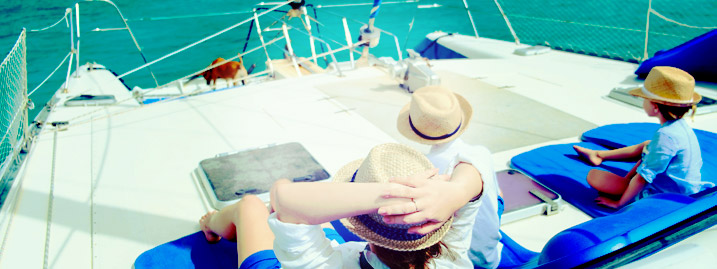
We know that sunlight is important for our health, as a source of vitamin D. But like most things in life, it is vital to get the balance right, or it might become a killer.
In my youth I was a real sun-worshipper and even in my forties, when I first took up sailing, I loved being in the Med, stripped off in a bikini, with only the minimum of sun screen, because I rarely burnt and not even bothering about a sunhat. In those days no-one mentioned the big C word and skin cancer was rarely discussed. Nowadays things are different – fortunately. We know a whole lot more about the dangers of exposure to the sun and the wind, but when you are on holiday doing something you love, it is easy to forget about the risks you may be taking; that sunlight reflects off water and can magnify the effects of UV radiation by up to 80% and that there’s no such thing as windburn; its still sunburn!
Much of the risk of skin cancer is genetic. History of cancer in your family, fair skin, blond or red hair, blue or green eyes and lots of freckles or moles; all these give you a higher risk. Also your personal history plays a big part; if you have spent a lot of unprotected time in the sun in your youth, had severe blistering sunburns or any forms of skin cancer or pre-cancerous growths in the past. But even if you don’t fall into any of these categories, you still need to take precautions.
Your tan
This is not going to be popular – but according to the Skin Cancer Foundation, “no tan is a good tan”. The reason for this is that tans are caused by ultraviolet radiation which is harmful to the skin. UVA rays have the deepest penetration and can cause the skin’s aging, wrinkles and cancer. UVB rays have a shorter wavelength and cause sunburn, skin damage and are closely linked to skin cancer. A tan may make you look good, but your skin is paying the price. At the best it will age you prematurely; at the worst it may give you skin cancer. Maybe those Victorian and Edwardian ladies who covered themselves up to go out had got it right after all.
I know a lot of people use sun-beds early in the season, or before a holiday, so that they look good from the start. Maybe they think that if they already have a tan, then they won’t be as likely to burn. The damage is already done! The lighting used in these machines can actually be more harmful than the sun and you don’t get any of the natural protection afforded by the clouds.
If you have young children and especially strong minded teenagers, you may have to keep on reminding them of the dangers. If you can convince them before a holiday starts, maybe by showing them pictures of skin damage or telling a few gruesome stories, it will lessen the need for continually nagging them on holiday and make for a happier boat.
Protection

Sunscreen – Look carefully at the SPF (Sun Protection Factor) and use a high one, (at least 30+), one which will provide you with UVA and UVB protection and one which is water resistant. Those that contain zinc oxide have good test results. Choose one that feels comfortable; not too runny, not too greasy. Buy an adequate supply, as when you are out at sea you won’t be able to run into the nearest pharmacy to restock. If possible apply it liberally 30 minutes before you go out in the sun and reapply every two hours or so. If you feel the sun warming your skin before that time, then reapply or cover up. Similarly if you are sweating profusely, go in the water, or dry yourself with a towel, don’t forget to reapply. It is all too easy for sailors to be too busy on deck to think about applying sunscreen or covering up, so try to get into a routine – it is important! Have a tube or bottle on deck that everyone is welcome to use as a top up. You’re far more likely to reapply if its really handy.
Hats – Choose a large brimmed hat which will protect your face, ears and neck and make sure you have a hat cord attached so you don’t loose it. Baseball hats are popular and comfortable but they don’t give the same amount of protection as a large brimmed hat. Those with a cloth drape at the back may look stupid, but they do give good protection. If anyone has the cheek to criticise your unfashionable look, you can always assure them that you will leave it at home when you attend their funeral. If you really hate wearing hats, a sun visor is the next best thing; not as good, but it will give you some protection.
Protective clothing – Specialist, comfortable sailing clothing, made from sun-protective material is getting more widely available and it is worth investing a little extra money. These carry a tag showing their UPF (ultra violet protective) rating, ranging from 10 (moderate) to 50 (excellent). Any fabric rated above UPF30 will provide good protection against UV radiation but 50+ is recommended. Some sailors are covering up completely now from head to toe. They may not look so macho, but what is more important, your “look” or your health? Loose fitting, collared shirts with long sleeves are recommended and at least three-quarter length trousers. Darker colours generally offer more protection than lighter colours.
Sun glasses – Long-term exposure to the sun can cause cataracts (a clouding in the lens of the eye which obscures vision) and skin cancer on the eyelids. It can also contribute to the formation of age-related macular degeneration. You should invest in good quality, wrap-around sunglasses with a UV filter. Don’t just choose ones that look fashionable and “cool”. Do your research and choose a pair that will give the protection you need. In fact it’s sensible to take 2 pairs with you in case one goes overboard. I talk from experience.
Awnings and dodgers – These at least will protect you from the direct sun even though they won’t help with reflected sunlight. If you have them, then use them, especially when sitting at anchor. You may think that they look a bit “uncool” and spoil the lines of your pride and joy but what price do you put on your health?
High risk periods – If you are sailing you probably won’t have the choice of staying out of the sun when it is at its strongest, so you must take even more care at these times.
Tips
- Avoid sunburns – even one bad burn could increase your risk of skin cancer so don’t take them lightly.
- After sailing, wash your face and preferably other parts that have been exposed, as the mix of sun block and salt can cause great damage. Reapply if you are going to stay in the sun, otherwise use some moisturiser to keep your skin from drying out.
- Don’t use sunscreen that is past its expiry date as it could damage your skin and don’t leave it in the sun or in a very hot place as it could lose its properties before the expiry date.
- Check your skin regularly, looking for any new growths, bumps, moles, freckles or birthmarks. Don’t forget the areas you can’t see – use a mirror or seek the help of a family member or good friend. If you have any worries at all get checked over by a skin cancer specialist so that any problems can be addressed in time.
- Be wary of using too much protective lipbalm when your lips get dry. Many don’t have SPF ratings and can cause damage, so take care which one you choose.
- Look at any medications you might be on. Some can actually increase the chance of your skin burning, so check with your doctor or pharmacist.
“The sailor’s disease”
Did you know that is what skin cancer is often known as? While most sailors’ fears concern storms at sea, falling overboard, collisions and dangerous rocks, these hazards don’t come any where near the statistical dangers posed by the sun.
I’d be the last to try to stop anyone taking advantage of a glorious, sunny day with the wind in your sails. There’s nothing like it! Just make sure you are well prepared and protected so that you live to enjoy many more in the future.

Author - Dee White